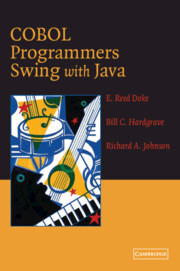Book contents
- Frontmatter
- Contents
- Preface
- Introduction
- Chapter 1 Why You Should Learn Java
- Chapter 2 An Introduction to Object-Oriented Programming
- Chapter 3 Java Structure
- Chapter 4 Defining Data
- Chapter 5 Computation
- Chapter 6 Decision Making
- Chapter 7 Loops
- Chapter 8 Arrays
- Chapter 9 Data Access
- Chapter 10 Graphical User Interfaces
- Chapter 11 Object-Oriented Development Issues
- Glossary
- Index
Chapter 5 - Computation
Published online by Cambridge University Press: 26 August 2009
- Frontmatter
- Contents
- Preface
- Introduction
- Chapter 1 Why You Should Learn Java
- Chapter 2 An Introduction to Object-Oriented Programming
- Chapter 3 Java Structure
- Chapter 4 Defining Data
- Chapter 5 Computation
- Chapter 6 Decision Making
- Chapter 7 Loops
- Chapter 8 Arrays
- Chapter 9 Data Access
- Chapter 10 Graphical User Interfaces
- Chapter 11 Object-Oriented Development Issues
- Glossary
- Index
Summary
OBJECTIVES
In this chapter you will study:
Exceptions;
Data types;
Type casting;
Wrapper classes;
Arithmetic operators;
The Math class; and
The NumberFormat class.
The purpose of this chapter is to introduce you to Java computation. The basic arithmetic operators add, subtract, multiply, and divide (+, -, *, /) are the same as those we use in COBOL's COMPUTE statement. However, Java operations such as exponentiation (raising a value to a power) and rounding are accomplished using methods in the Math class. Java also has operators that enable us to write computation shortcuts if we wish.
Also, you will recall from Chapter 4 that Java is very particular about data types. This sensitivity is raised to a higher level when we do computation, as discussed more thoroughly in this chapter.
The chapter begins with a discussion of Java exceptions. An exception is Java's way of informing us of some condition that occurs while our program is running. While doing computation, for example, this could be an error like dividing by zero. Exceptions are not limited to arithmetic, however. You will see how exceptions are used to signal us about any condition, ranging from computation errors to hardware problems. In this chapter we will illustrate the use of custom exceptions using the familiar CheckingAccount class developed in Chapter 3.
- Type
- Chapter
- Information
- COBOL Programmers Swing with Java , pp. 82 - 107Publisher: Cambridge University PressPrint publication year: 2004



